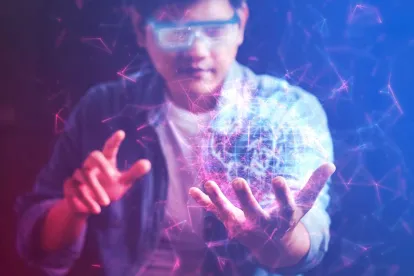The Metaverse presents a variety of possibilities: from technology that enables digital content to be laid over the real world to application of real-world characteristics to a purely online environment. It is also a combination of various features and goals, including at least a sense of immersion, real-time interactivity, user agency, platform and device interoperability, and concurrent interaction between thousands of people simultaneously.
Many businesses seek the promise the Metaverse brings of more accessible goods, information, products, entertainment, and social experiences, without geographic restriction or limitation. With the rise of non-fungible tokens (NFTs) and cryptocurrencies, the possibilities of what businesses can trade, invest in, or purchase could be endless.
As a result of the opportunities and capabilities the Metaverse will offer, hardware technology and software development will dominate the technology market. For example, compute infrastructure, network infrastructure, and interface hardware may need to be improved to allow numerous users to be online at once without overloading processing resources, latency in gaming and socializing to be reduced, and extended reality (XR) devices (e.g., augmented reality (AR) and virtual reality (VR)) that access the Metaverse to evolve. Advances in current technologies utilized for the Metaverse may also be needed, including distributed ledger technology (e.g., blockchain, which allows for the creation of unalterable or “immutable” records of transactions of goods or services in the Metaverse), smart contracts (self-executing computer code stored on a blockchain which may execute specific actions in response to certain triggers, such as distributing resale royalties to NFT creators in response to each NFT resale), and cryptocurrency (digital currency using cryptography for security which may be used to validate and record transactions to a blockchain).
Artificial intelligence (AI) especially is a technology which will be strongly applied in the Metaverse. For example, AI may be used to enable accessibility to the Metaverse (e.g., via image recognition and behavioral analysis), manage the hardware and software infrastructure of the Metaverse, create digital assets based on user inputs in the Metaverse, provide immersive digital worlds, use smart contracts, promote personalized experiences, and much more. Indeed, the United States Patent and Trademark Office (USPTO) has defined AI as comprising numerous component technologies, including knowledge processing, speech, AI hardware, evolutionary computation, natural language processing, machine learning, vision, and planning/control. Moreover, as the demand for AI continues to increase, the USPTO has deemed it a key technology and has formed an AI initiative that focuses on incentivizing and protecting innovation in this key technology (as well as other emerging technologies).
Protecting Assets in the Metaverse with Patents
With all of these developments surrounding the Metaverse, there has been a rise in uncertainty in the area of intellectual property (IP) law in connection with how IP owners can ensure their assets are protected as the physical and virtual worlds converge, particularly with respect to patents and AI-created inventions.
Under the U.S. Patent Act, 35 U.S.C. §§ 1 et seq., a patent grants a patent holder the exclusive right to exclude others from making, using, importing, and selling a patented invention for a limited period of time. Many patented inventions concern cryptocurrencies and blockchain, AR/VR, and other technologies prevalent in the Metaverse.
However, the computer-implemented nature of the Metaverse may give rise to various challenges in licensing and protecting Metaverse-related patents. For example, while owning a patent in AR or VR technology may provide a significant opportunity for licensing revenue, it may be difficult for patent owners to detect third party users of this technology as possible licensees without first obtaining their source code in discovery. Moreover, following Alice Corp. v. CLS Bank International, 573 U.S. 208 (2014) and its progeny, there are risks of a software-focused patent being invalidated as patent ineligible under 35 U.S.C. §101, and the U.S. Supreme Court has yet to clarify patent eligibility law following its denial of certiorari recently in Worlds Inc. v. Activision Blizzard Inc., Case No. 21-1554 (denying certiorari where Federal Circuit found patent claims directed to a method of avatar crowd control in a virtual space based on filtering of avatar positioning information as a patent ineligible abstract idea).
With respect to patents focused on AI technology, questions as to inventorship and infringement have also arisen for AI-created inventions. For example, it has been long established in the United States and other countries that only human beings may be recognized as inventors of a patent. However, AI has become not only a useful technology in advancing the Metaverse, but also a creative partner in innovation efforts, generating its own inventions without human intervention. As a result, this norm of inventorship has come under challenge (although unsuccessfully as of yet). See, for example, Thaler v. Vidal, Appeal No. 2021-2347, slip. op. (Fed. Cir. Aug. 5, 2022) (affirming USPTO’s holding that the Patent Act defines the term “inventor” as being limited to a natural person or human being). On the enforcement side, there is a possibility that actions performed by an AI, rather than by a human being, result in use or other infringing activity of a patented invention. In such case, to attach liability to a human being for patent infringement, patent owners may need to prove that the human being who created the AI is the one who caused the AI to practice the elements of a claim of a patented invention (in direct infringement), or who knowingly induced the AI’s infringing acts (in induced infringement).
Accordingly, patent owners should adapt their patent protection and enforcement strategies in view of the current legal landscape surrounding patents in the Metaverse, especially for AI-related inventions. For example, to try to avoid situations where the inventor of an AI-patent is considered to be the AI itself, patent owners may advise inventors to write down the details of their conception and practice of their inventions to establish a record showing the AI was used as a tool to create the invention rather than the creator of the invention itself. Also, patent practitioners who draft patents for an AI-related invention may formulate the description and claims in a manner in attempt to make clear that the novel aspects are attributable to a human being. Moreover, as the USPTO has considered AI-related inventions to be a subset of computer-implemented inventions, patent owners should consider existing USPTO guidance regarding computer-implemented inventions when seeking patent protection for AI-related inventions.
Conclusion
In light of the growing demands of technology and business opportunities in the Metaverse, businesses should reevaluate their patent protection and enforcement strategies to account for the challenges that may arise in the new virtual world.




 />i
/>i

